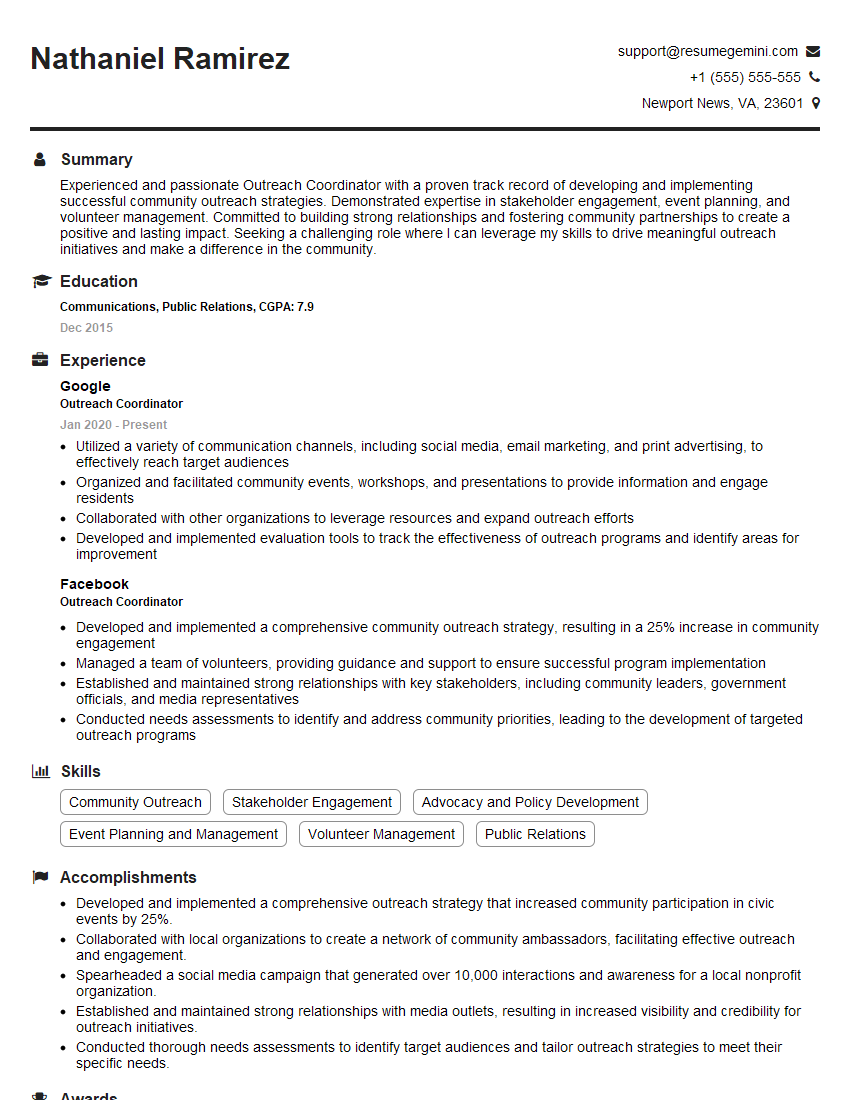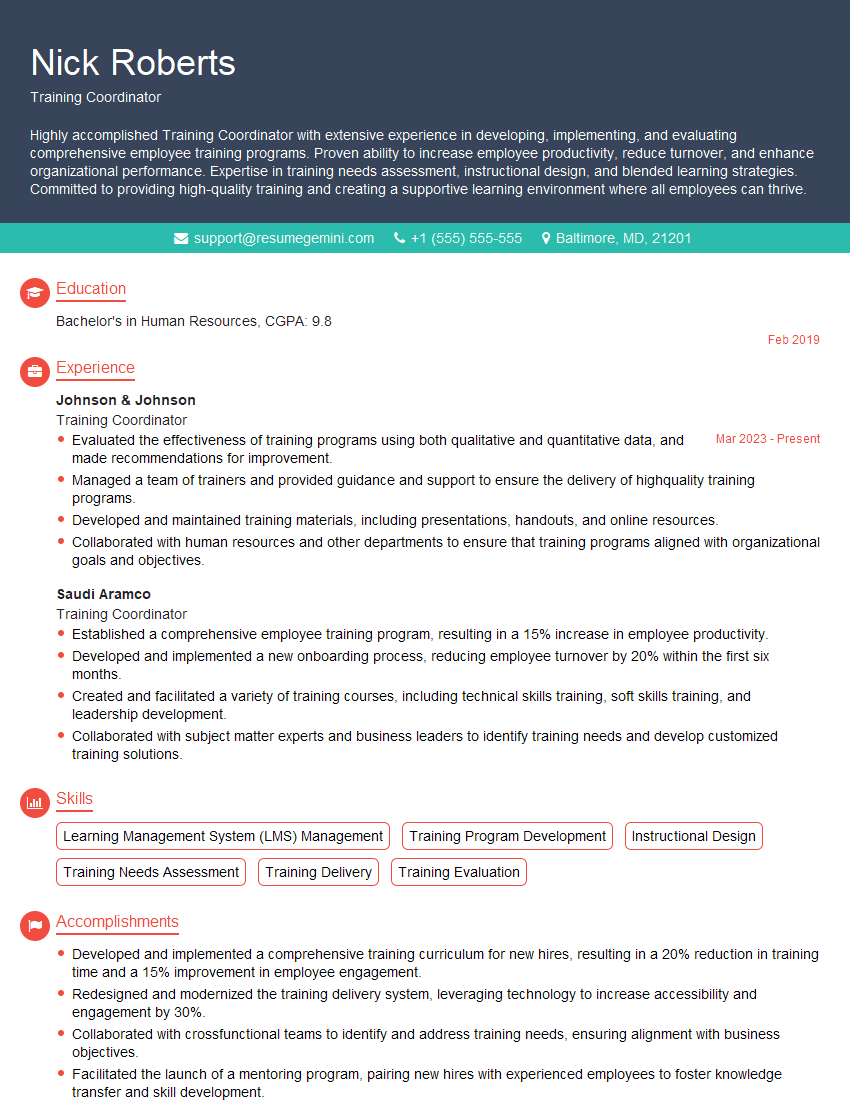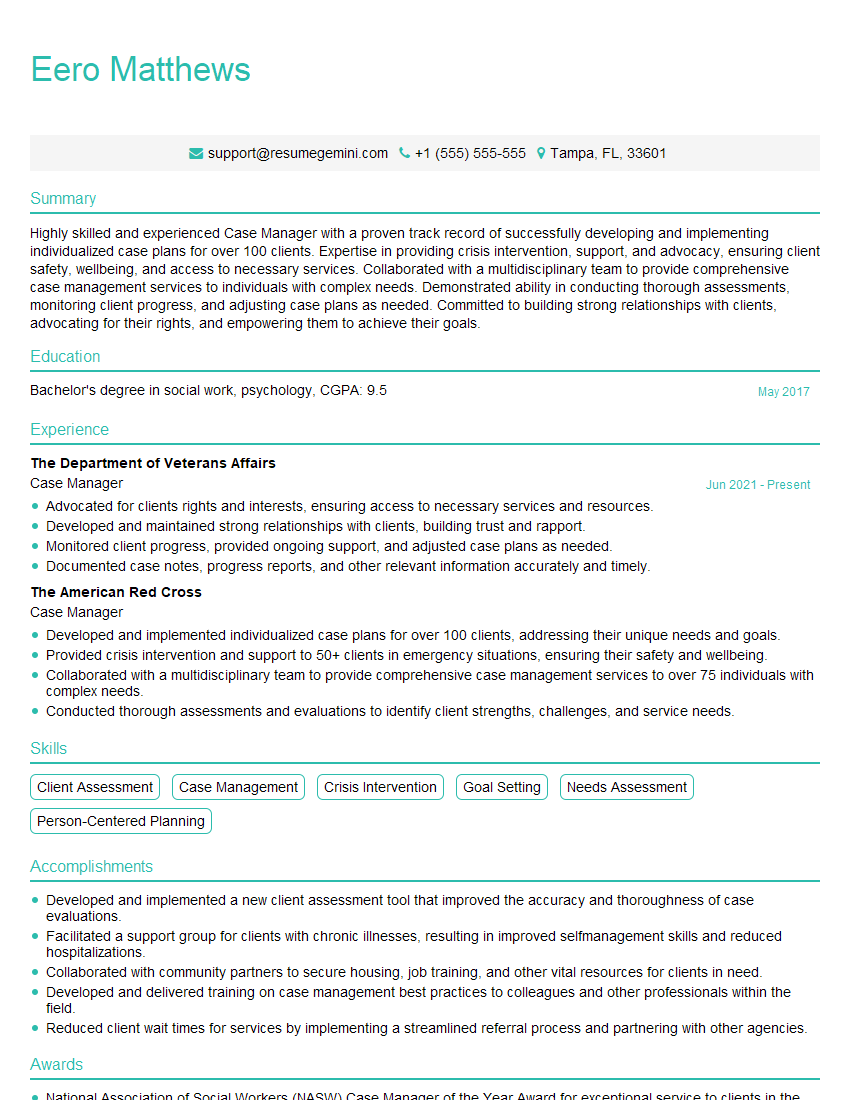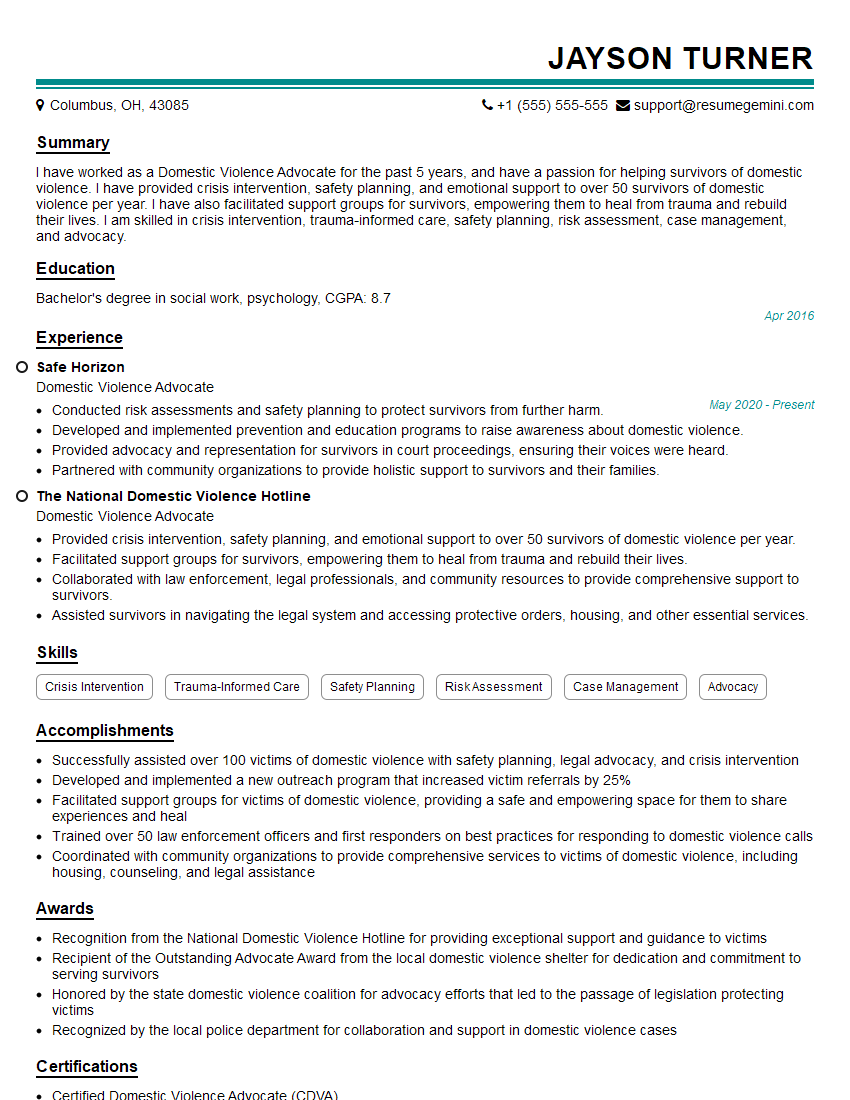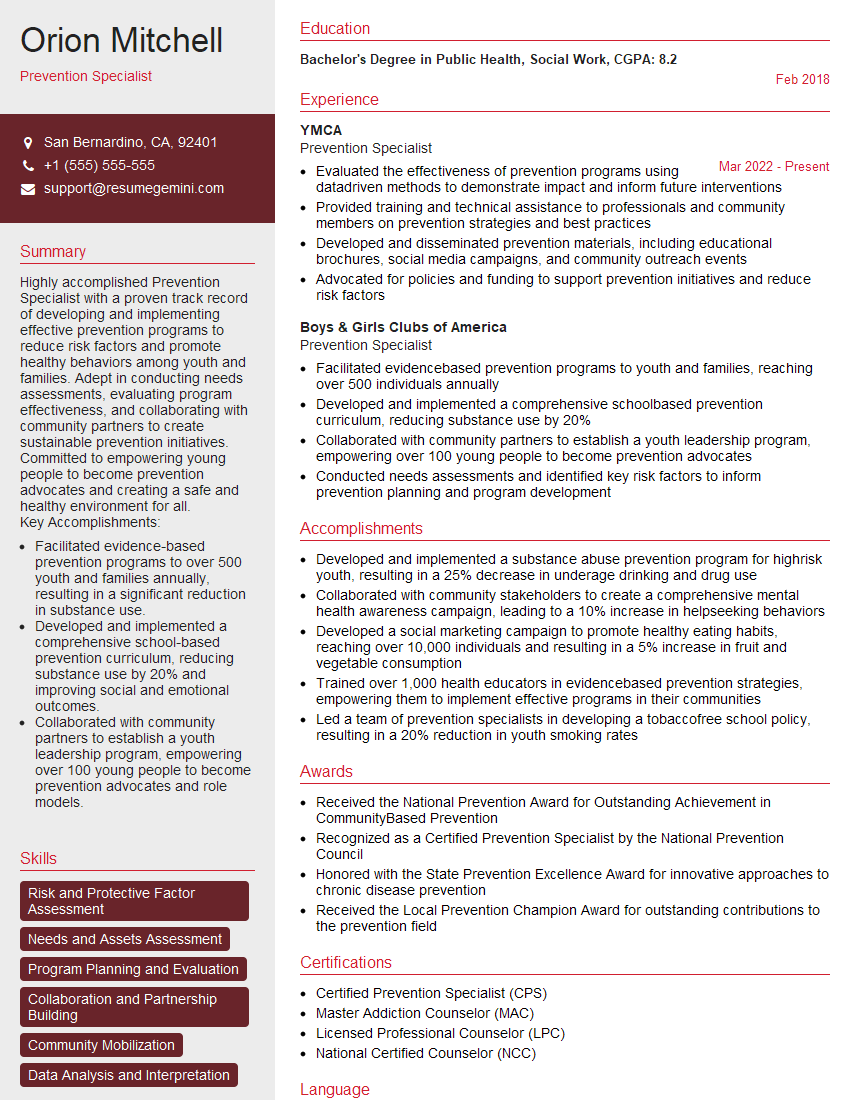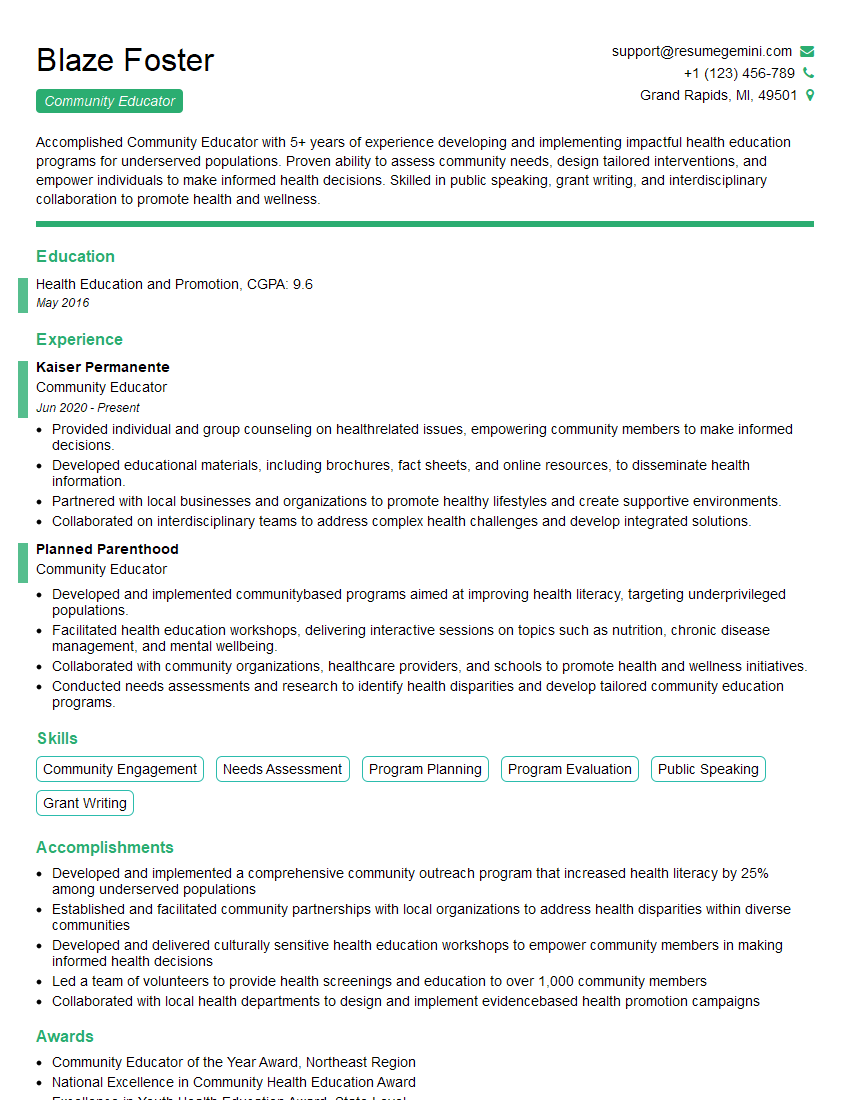Unlock your full potential by mastering the most common Victim Empowerment interview questions. This blog offers a deep dive into the critical topics, ensuring you’re not only prepared to answer but to excel. With these insights, you’ll approach your interview with clarity and confidence.
Questions Asked in Victim Empowerment Interview
Q 1. Describe your experience providing direct support to victims of crime.
My experience in providing direct support to victims of crime spans over ten years, working in various settings including crisis hotlines, shelters, and community-based organizations. I’ve worked with individuals who have experienced a wide range of victimizations, from domestic violence and sexual assault to robbery and elder abuse. My role has involved providing immediate crisis intervention, safety planning, emotional support, and connecting victims with necessary resources such as legal assistance, medical care, and mental health services.
For instance, I remember supporting a young woman who had recently escaped an abusive relationship. She was terrified, disoriented, and had very few resources. My work focused on creating a safe environment, assessing her immediate needs (shelter, food, medical attention), and developing a safety plan that involved securing a restraining order and connecting her with a therapist specialized in trauma. This case highlights the importance of individualized care and the critical role of building trust to foster empowerment.
Q 2. Explain your understanding of trauma-informed care and its application in victim services.
Trauma-informed care is a strength-based approach that recognizes the profound and pervasive impact of trauma on an individual’s life. It shifts the focus from what is wrong with a victim to understanding how their experiences have shaped their behaviors and responses. It emphasizes safety, trustworthiness, choice, collaboration, and empowerment. In victim services, this means creating a supportive environment where victims feel safe to share their experiences without judgment, and where their needs and preferences are prioritized.
For example, instead of immediately pushing a victim to recount details of their trauma, a trauma-informed approach might start with building rapport, offering choices in the services provided, and respecting their pace. It involves recognizing that triggers may arise and managing them with sensitivity. Practical applications include providing flexible appointment scheduling, offering alternative communication methods if needed, and using a calm and validating tone throughout interactions.
Q 3. How would you assess a victim’s immediate needs during a crisis?
Assessing a victim’s immediate needs during a crisis requires a structured yet flexible approach. It involves prioritizing safety, physical needs, and emotional stabilization. I use a holistic assessment framework that considers physical safety (shelter, medical attention), basic needs (food, clothing, transportation), emotional well-being (anxiety, depression, PTSD symptoms), legal and financial needs (restraining orders, financial assistance), and social support (family, friends, community resources).
This assessment involves active listening, observing nonverbal cues, and asking open-ended questions. For example, I might ask, “What is your biggest concern right now?” or “What do you need most from me today?” The responses guide the prioritization of immediate actions. Careful documentation of this assessment is crucial for continuity of care and appropriate resource allocation.
Q 4. What strategies do you use to build rapport and trust with victims?
Building rapport and trust with victims is paramount. It’s achieved through active listening, empathy, and demonstrating genuine care. I create a safe and non-judgmental space where victims feel comfortable sharing their experiences without fear of blame or criticism. This involves using validating language, mirroring their emotional state, and respecting their boundaries.
I utilize several strategies: First, I introduce myself clearly and explain my role. Second, I listen attentively without interruption and reflect back what I’m hearing to ensure understanding. Third, I validate their feelings and experiences without minimizing their trauma. Fourth, I use clear and simple language, avoiding jargon, and I provide choices whenever possible to maintain a sense of control. Finally, I consistently follow through on promises and demonstrate accountability, building reliability and fostering trust over time.
Q 5. Describe your experience advocating for victims’ rights within the legal system.
My advocacy work for victims within the legal system involves assisting them in navigating the complexities of the justice system. This includes accompanying them to court proceedings, preparing them for testimony, assisting with the preparation of victim impact statements, and helping them understand their rights throughout the process. I work closely with law enforcement, prosecutors, and defense attorneys to ensure the victims’ voices are heard and their needs are addressed. I am also involved in advocating for policy changes that improve victim support and protection.
One successful case involved working with a domestic violence survivor to navigate the legal system. I helped her secure a restraining order, obtain legal representation, and prepare her testimony. Her courage and the collaborative effort resulted in a successful prosecution. This experience underscores the importance of understanding legal processes, effective communication, and consistent support in empowering victims to seek justice.
Q 6. How do you handle situations where a victim is reluctant to engage in services?
When a victim is reluctant to engage in services, it’s crucial to understand the underlying reasons for their hesitation. This might stem from fear, mistrust, shame, or cultural barriers. I use a non-pressuring approach, respecting their autonomy and decision-making capacity. I emphasize that services are voluntary and available at their pace. I focus on building trust and rapport first before attempting to engage them in more formal services.
My strategy involves offering a range of options, including informal support, practical assistance, and information dissemination. I might start with small, less demanding interactions, like a brief phone call or providing written information about resources. I consistently check in and show respect for their boundaries, ensuring that they feel empowered to seek help when ready. Persistence, patience, and demonstrating genuine concern are key in this process.
Q 7. Explain your understanding of different types of abuse and their impact on victims.
My understanding of different types of abuse is comprehensive and includes physical, emotional, sexual, financial, and psychological abuse. Each type of abuse has unique characteristics but often overlaps and contributes to a complex pattern of control and harm. For instance, physical abuse might involve physical harm or threats, while emotional abuse includes manipulation, intimidation, and degradation. Sexual abuse encompasses any unwanted sexual act, and financial abuse involves controlling or misappropriating a victim’s finances. Psychological abuse is aimed at damaging a victim’s sense of self-worth and independence.
The impact of abuse varies greatly depending on factors like the type of abuse, the duration, the relationship between the abuser and victim, and the victim’s resilience. However, common effects include PTSD, anxiety, depression, substance abuse, difficulties in relationships, and lower self-esteem. It is vital to provide support that addresses the specific impact of each type of abuse and empower victims to rebuild their lives.
Q 8. How do you ensure confidentiality and maintain ethical boundaries with victims?
Confidentiality and ethical boundaries are paramount in victim empowerment. It’s built on trust, and without it, victims are unlikely to engage fully. This means adhering strictly to professional codes of conduct and relevant legislation. For example, I only share information with other professionals involved in the case with the victim’s explicit consent and only the minimum necessary information for their role.
I always clearly explain my role and limitations upfront, making sure the victim understands their rights and options regarding information sharing. Think of it like a locked box – the key is in the victim’s hands. They control who gets access and what they see. Documentation is crucial, but all records are securely stored and only accessible to authorized personnel. Maintaining appropriate professional distance is also key, avoiding dual relationships or personal disclosure that could compromise the therapeutic relationship. This ensures a safe and respectful environment for healing.
Q 9. Describe your experience facilitating support groups or individual counseling.
I have extensive experience facilitating both individual counseling and support groups for victims of various traumas. In individual sessions, I use a trauma-informed approach, focusing on building rapport, validating their experiences, and empowering them to regain control of their lives. This might involve exploring coping mechanisms, processing emotions, and developing safety plans.
Support groups offer a different dynamic. They provide a safe space for peer-to-peer support, allowing victims to share their experiences and learn from others. I facilitate these groups by creating a structured environment, guiding discussions, promoting active listening, and ensuring everyone feels heard and respected. For instance, I’ve led groups for survivors of domestic violence, helping them navigate the legal system, rebuild their lives, and find support within the community. A critical element in both settings is ensuring all participants understand their agency and setting boundaries to prevent them from re-traumatizing each other.
Q 10. How do you identify and address secondary trauma in yourself and colleagues?
Secondary trauma, the emotional distress resulting from exposure to others’ traumatic experiences, is a significant concern for professionals in this field. We address this proactively through self-care practices and regular supervision. Self-care might include regular exercise, mindfulness techniques, hobbies, or spending time with supportive loved ones – anything that allows us to decompress and recharge.
Supervision provides a crucial space to process challenging cases, discuss ethical dilemmas, and identify signs of secondary trauma. Supervisors help us to maintain our own well-being and provide strategies for managing the emotional burden of our work. We also have access to employee assistance programs (EAPs) which provide confidential counseling and support. Regular team meetings also provide a platform for sharing experiences and strategies for coping with the emotional demands of the job. Think of it as a support system for the support system; we need to take care of ourselves to best support others.
Q 11. What are your strategies for managing difficult or challenging interactions with victims?
Difficult interactions with victims can arise for various reasons, including anger, mistrust, or conflicting expectations. My approach prioritizes empathy, patience, and active listening. I try to understand their perspective and validate their feelings, even if I don’t necessarily agree with their approach.
I utilize de-escalation techniques, employing calm communication, and offering choices whenever possible. Setting clear boundaries while remaining respectful is crucial. If a situation becomes unmanageable, I always have access to additional support, including colleagues, supervisors, or security personnel, depending on the nature of the difficulty. The key is to always prioritize the victim’s safety and well-being, even when the interaction is challenging. For example, I might offer a break or reschedule the meeting if the victim is overwhelmed. The goal is to create a safe environment, even if progress feels slow.
Q 12. Explain your knowledge of relevant legislation related to victim services.
My knowledge of relevant legislation is critical to my work. This includes laws concerning victim rights, confidentiality, data protection, and reporting obligations. For example, I am well-versed in laws related to mandatory reporting of child abuse or elder abuse, understanding the specific circumstances requiring intervention and the procedures involved.
I understand the legal frameworks around accessing victim services, including the rights to compensation, protection orders, and legal assistance. Staying updated on legislative changes is crucial because laws evolve, and it is imperative that my practice remains compliant and responsive to these changes. This knowledge ensures I can effectively advocate for victims and assist them in navigating the legal system and accessing the services they need. It’s vital that I’m not just knowledgeable in the legislation but also able to explain it clearly to victims in a way they can understand.
Q 13. How do you work collaboratively with other agencies and professionals to support victims?
Collaboration is essential for effective victim support. I regularly work with law enforcement, social services, healthcare providers, legal professionals, and other relevant agencies. This involves effective communication, sharing information (while adhering to confidentiality protocols), and coordinating services to provide holistic support.
For example, I might work with the police to ensure a victim’s safety, connect them with legal aid for representation, and collaborate with social workers to help them access housing and financial assistance. Regular case conferences are a common approach to facilitate this, providing opportunities for a multidisciplinary team to develop a coordinated care plan. Building strong relationships with other agencies and professionals is also crucial to facilitating seamless transitions and minimizing any disruption or further trauma for the victim.
Q 14. Describe your experience developing and implementing prevention programs.
I have experience in developing and implementing prevention programs focusing on education and community awareness. This might involve creating workshops for schools, community groups, or workplaces to educate people about various forms of violence, abuse, and exploitation.
These programs aim to raise awareness of risk factors, promote healthy relationships, and equip individuals with the knowledge and skills to prevent violence. For instance, I’ve developed programs focusing on healthy relationships in schools for adolescents, providing them with skills and information to identify and avoid abusive situations. Evaluation and data analysis are critical steps in program development to determine their effectiveness and inform necessary modifications or improvements. The success of prevention programs is measured not just by participation but by changes in attitudes and behaviors within the target population.
Q 15. What are your skills in crisis intervention and de-escalation techniques?
My crisis intervention skills are built on a foundation of active listening, empathy, and a trauma-informed approach. I’m trained in various de-escalation techniques, including validating the victim’s emotions, using calm and reassuring language, and offering choices to regain a sense of control. For example, if a victim is overwhelmed with anger, I might say, “I understand you’re feeling furious right now. Would you prefer to sit down for a moment, or would you like some water?” This offers choices, allowing them to feel empowered in a crisis. I also utilize techniques to assess the immediate risk level and ensure safety, prioritizing their physical and emotional well-being.
I’m proficient in techniques such as motivational interviewing, which helps victims explore their own solutions and build self-efficacy. Furthermore, I can assess for suicidal ideation or other self-harm risks and provide appropriate interventions or connect them with emergency services if necessary.
Career Expert Tips:
- Ace those interviews! Prepare effectively by reviewing the Top 50 Most Common Interview Questions on ResumeGemini.
- Navigate your job search with confidence! Explore a wide range of Career Tips on ResumeGemini. Learn about common challenges and recommendations to overcome them.
- Craft the perfect resume! Master the Art of Resume Writing with ResumeGemini’s guide. Showcase your unique qualifications and achievements effectively.
- Don’t miss out on holiday savings! Build your dream resume with ResumeGemini’s ATS optimized templates.
Q 16. How do you assess the safety and risk factors for victims?
Assessing safety and risk involves a holistic approach, considering various factors. I use standardized risk assessment tools, but also rely on my clinical judgment and intuition gained from years of experience. This includes understanding the nature of the abuse (physical, emotional, sexual, financial, etc.), the perpetrator’s history of violence, the availability of support systems, and the victim’s current coping mechanisms.
For instance, I might use a structured assessment that scores factors such as the severity of the abuse, the perpetrator’s access to the victim, and the victim’s ability to escape the situation. This leads to a risk profile which guides the development of a safety plan. Key factors considered include the presence of lethal means in the home, threats made by the perpetrator, and the victim’s access to resources. I work collaboratively with the victim to develop strategies, such as creating a safe space, identifying trusted individuals, and devising an escape plan.
Q 17. Describe your experience in case management and service coordination.
My case management experience encompasses a wide range of activities, from intake and assessment to service coordination and ongoing support. I’m adept at navigating complex systems, connecting victims with necessary resources like legal aid, shelters, therapy, and financial assistance. I maintain detailed case files, track progress, and advocate for my clients’ needs.
For example, I recently worked with a victim of domestic violence who needed legal representation, temporary housing, and counseling. I coordinated these services, ensuring that they received seamless support. This included regular check-ins, advocating for expedited service delivery, and facilitating communication between the different providers to avoid duplication of effort and ensure the client received holistic support. I document every step in the process, ensuring accountability and maintaining a comprehensive record of their journey.
Q 18. How do you handle situations involving conflicting information or differing perspectives?
Conflicting information or differing perspectives are common in these situations, and my approach focuses on creating a safe and non-judgmental space where everyone feels heard. I prioritize active listening, asking clarifying questions to understand each viewpoint, and acknowledging the validity of everyone’s experiences. I avoid taking sides and instead focus on finding common ground to move forward collaboratively.
In one case, a victim’s account differed from witness testimonies, causing confusion. I engaged in careful questioning of all parties, confirming the facts that weren’t in dispute, and ensuring everyone felt heard. I emphasized that the focus was on the victim’s safety and well-being, and that different perspectives don’t negate the experience of abuse. Ultimately, it allowed us to identify common areas for support, focusing on what we all agreed on and minimizing the points of contention.
Q 19. How do you ensure culturally sensitive and appropriate service delivery?
Culturally sensitive service delivery is paramount. It involves recognizing that each individual’s experience is shaped by their unique cultural background, beliefs, and values. I’m committed to providing care that respects these differences, avoiding cultural bias and ensuring that services are accessible and appropriate for diverse communities.
For example, I utilize interpreters when necessary, considering the client’s language and communication preferences. I also take into account religious beliefs or cultural norms when discussing treatment options or developing safety plans, ensuring they align with the individual’s cultural context. This includes being aware of and sensitive to power dynamics, gender roles, and family structures within various cultures. I engage in ongoing professional development to stay informed about cultural competency best practices.
Q 20. What are your skills in documentation and record-keeping?
My documentation and record-keeping skills are meticulous. I use electronic health records (EHR) to maintain comprehensive case notes, ensuring accurate and timely documentation of all interactions, assessments, interventions, and outcomes. My records adhere to all relevant confidentiality and privacy regulations.
This includes detailing the client’s history, risk assessments, safety plans, service referrals, and progress notes. I use a clear and concise writing style, avoiding jargon and using plain language. Maintaining accurate and detailed records is crucial for continuity of care, allowing other professionals to readily understand the client’s history and treatment plan, ensuring effective collaboration and reducing the risk of errors. I’m also trained on secure data handling practices and maintaining confidentiality.
Q 21. Explain your knowledge of community resources and referral networks.
I possess extensive knowledge of community resources, including shelters, legal aid organizations, mental health services, domestic violence hotlines, and support groups. My referral network is constantly updated, and I’m familiar with the eligibility criteria and services offered by each organization.
I regularly attend conferences and workshops to stay abreast of new developments and resources in the community. I build relationships with key personnel at different agencies, ensuring smooth referral processes and efficient coordination of services. This allows me to provide tailored referrals that best meet the specific needs of each individual. For example, I am aware of specialized resources available for survivors of specific types of abuse or belonging to particular ethnic or socioeconomic groups.
Q 22. How do you measure the effectiveness of your work with victims?
Measuring the effectiveness of victim empowerment work requires a multifaceted approach, going beyond simple numbers. We use a combination of quantitative and qualitative methods.
Quantitative Measures: These include tracking the number of victims served, their participation in various programs (e.g., support groups, legal assistance), and changes in their reported levels of fear, anxiety, and PTSD symptoms using standardized questionnaires like the Impact of Event Scale-Revised (IES-R). We also track recidivism rates where applicable, showing the long-term impact of our interventions.
Qualitative Measures: These are crucial for understanding the nuanced impact of our work. We conduct in-depth interviews and focus groups to gather feedback on clients’ experiences, assess their perceived changes in coping mechanisms, self-efficacy, and overall well-being. Analyzing narratives allows us to understand the effectiveness of our interventions beyond just numbers.
Outcome Measurement: We also focus on measuring outcomes that demonstrate a victim’s increased control over their lives, such as securing housing, employment, or completing educational goals. This holistic assessment provides a complete picture of our impact.
For example, we might track a decrease in reliance on emergency services or increased self-reported confidence in navigating the justice system, signifying successful empowerment.
Q 23. Describe your experience working with diverse populations and cultural backgrounds.
Working with diverse populations is fundamental to effective victim advocacy. My experience spans various cultural backgrounds, including working with immigrant communities, LGBTQ+ individuals, and people with disabilities. I’ve learned to adapt my approach to respect cultural sensitivities and communication styles. This includes understanding how trauma manifests differently across cultures and how cultural beliefs might influence a victim’s willingness to seek help.
Culturally Sensitive Approach: I prioritize building trust by actively listening, demonstrating respect for their beliefs, and employing culturally appropriate communication methods. This might involve using interpreters, engaging community leaders, or tailoring services to align with their cultural norms and values.
Addressing Systemic Barriers: I recognize that marginalized groups often face unique obstacles in accessing support, such as language barriers, lack of culturally competent services, and discrimination within systems. I actively work to remove these barriers and advocate for equitable access to resources.
Collaboration: I collaborate closely with community organizations and cultural leaders to ensure that our services are culturally responsive and effectively reach those most in need. This includes understanding the unique needs of diverse victim populations and tailoring support accordingly.
For instance, I worked with a refugee community where trust was initially low due to past experiences with authority figures. By collaborating with a trusted community leader, I was able to build rapport and provide culturally appropriate support.
Q 24. Explain your understanding of the impact of trauma on various aspects of a victim’s life.
Trauma’s impact is far-reaching, affecting every aspect of a victim’s life. It’s not just an emotional response; it’s a deeply ingrained physiological and psychological alteration.
Psychological Impacts: This includes PTSD, depression, anxiety, panic attacks, difficulty sleeping, hypervigilance, flashbacks, and emotional numbness. Victims may struggle with intrusive thoughts, nightmares, and difficulty concentrating.
Physical Impacts: Trauma can manifest physically with chronic pain, headaches, digestive problems, immune system dysfunction, and increased susceptibility to illness. The body’s stress response is constantly activated.
Social Impacts: Victims might experience strained relationships, social isolation, difficulty trusting others, and challenges in maintaining healthy relationships. They might feel shame, guilt, or a sense of powerlessness.
Behavioral Impacts: This can include changes in lifestyle, increased substance use, risky behaviors, avoidance of reminders of the trauma, and difficulty regulating emotions.
Understanding these multifaceted impacts is crucial for developing holistic support plans. For example, a victim of domestic violence might experience not only emotional distress but also financial insecurity, leading to housing instability and further exacerbating their trauma.
Q 25. How do you advocate for policy changes that benefit victims?
Advocating for policy changes requires strategic engagement at multiple levels.
Data-Driven Advocacy: I use data to demonstrate the need for change. This involves analyzing crime statistics, service utilization rates, and client outcomes to highlight gaps in the system and the impact of current policies (or lack thereof). This builds a strong case for change based on evidence.
Collaboration and Coalition Building: I work with other organizations, victim advocacy groups, and community stakeholders to build a powerful coalition. This unified voice is much stronger than individual efforts in lobbying for change.
Direct Lobbying and Public Awareness Campaigns: This involves directly engaging with legislators, providing testimony at hearings, and participating in policy discussions. We also launch public awareness campaigns to educate the public about the importance of specific policy changes and their impact on victims.
Grassroots Mobilization: Empowering victims to tell their stories and participate in advocacy efforts is vital. Their lived experiences are powerful tools for influencing policymakers.
For instance, I’ve worked on campaigns to improve access to legal services for survivors of domestic violence and to strengthen protective orders.
Q 26. What are your strengths and weaknesses in a victim advocacy role?
My strengths lie in my empathy, strong communication skills, and dedication to empowering victims. I am adept at building rapport, actively listening, and tailoring my approach to individual needs. I am also highly organized and effective at managing complex cases and collaborating with multiple stakeholders.
However, like everyone, I have areas for growth. Maintaining emotional detachment can be challenging when working with victims who have experienced significant trauma. To mitigate this, I engage in regular self-care, utilize supervision, and maintain clear boundaries.
Q 27. Describe your experience with grant writing or fundraising for victim services.
I have extensive experience in grant writing and fundraising for victim services. I understand the intricacies of proposal development, budget management, and reporting requirements. I am skilled in identifying funding opportunities, crafting compelling narratives that resonate with funders, and effectively managing the grant lifecycle.
Needs Assessment: I begin with a thorough needs assessment to identify the specific services and resources needed by the target population.
Strategic Planning: A clear plan outlines goals, objectives, activities, and expected outcomes. This provides a roadmap for achieving the project’s goals.
Compelling Narrative: Grant proposals must tell a compelling story that demonstrates the need for funding and the project’s potential impact. Strong writing skills are essential.
Budget Development: Accurate and detailed budgeting is crucial, demonstrating fiscal responsibility and outlining how funds will be utilized to achieve the project’s goals.
I have successfully secured grants from various foundations and government agencies to support programs for survivors of domestic violence, sexual assault, and human trafficking.
Q 28. How do you maintain professional boundaries while fostering empathy and understanding?
Maintaining professional boundaries while fostering empathy and understanding is crucial for ethical and effective victim advocacy. It’s about establishing a safe and supportive environment without blurring the lines between professional and personal relationships.
Clear Communication: I clearly define my role and the boundaries of the professional relationship at the outset. This includes explaining what support I can offer and what I cannot.
Self-Reflection and Supervision: Regular self-reflection and supervision help me process my experiences and identify any potential boundary issues. This is essential for maintaining emotional well-being.
Referrals: When necessary, I refer clients to other professionals for specific needs (e.g., therapy, legal representation). This ensures they receive specialized assistance while upholding ethical boundaries.
Personal Life Separation: I maintain a strict separation between my personal life and my professional work to avoid any potential conflicts of interest or emotional entanglement.
Empathy is about understanding and sharing the feelings of the victim without becoming personally involved. It’s about providing support and advocacy within the confines of professional ethics.
Key Topics to Learn for Victim Empowerment Interview
- Trauma-Informed Care: Understanding the impact of trauma on victims and applying trauma-sensitive approaches in support services.
- Empowerment Models and Theories: Familiarize yourself with various theoretical frameworks guiding victim empowerment practices, and be prepared to discuss their practical applications in real-world scenarios.
- Advocacy and Case Management: Learn about effective advocacy strategies, navigating legal and social systems, and providing comprehensive case management support to victims.
- Crisis Intervention and Stabilization: Understand techniques for immediate crisis intervention, de-escalation, and providing short-term stabilization support to individuals experiencing acute distress.
- Safety Planning and Risk Assessment: Develop a strong understanding of safety planning methodologies and risk assessment tools to ensure the safety and well-being of victims.
- Ethical Considerations and Boundaries: Discuss the ethical implications of working with victims and the importance of maintaining professional boundaries.
- Collaboration and Networking: Understand the importance of building strong inter-agency collaborations to provide holistic support to victims.
- Program Evaluation and Outcomes Measurement: Familiarize yourself with methods for evaluating the effectiveness of victim empowerment programs and measuring positive outcomes.
- Cultural Competency and Diversity: Learn about the importance of cultural sensitivity and understanding the unique needs of diverse victim populations.
- Self-Care and Burnout Prevention: Discuss strategies for maintaining personal well-being and preventing burnout in this demanding field.
Next Steps
Mastering Victim Empowerment is crucial for a rewarding and impactful career. It demonstrates a deep commitment to social justice and a genuine desire to help vulnerable individuals. To significantly boost your job prospects, crafting an ATS-friendly resume is vital. This ensures your qualifications are effectively communicated to potential employers. We strongly recommend using ResumeGemini to build a professional and compelling resume. ResumeGemini provides a user-friendly platform and offers examples of resumes tailored to the Victim Empowerment field, helping you present your skills and experience in the best possible light.
Explore more articles
Users Rating of Our Blogs
Share Your Experience
We value your feedback! Please rate our content and share your thoughts (optional).
What Readers Say About Our Blog
Hi, I have something for you and recorded a quick Loom video to show the kind of value I can bring to you.
Even if we don’t work together, I’m confident you’ll take away something valuable and learn a few new ideas.
Here’s the link: https://bit.ly/loom-video-daniel
Would love your thoughts after watching!
– Daniel
This was kind of a unique content I found around the specialized skills. Very helpful questions and good detailed answers.
Very Helpful blog, thank you Interviewgemini team.
